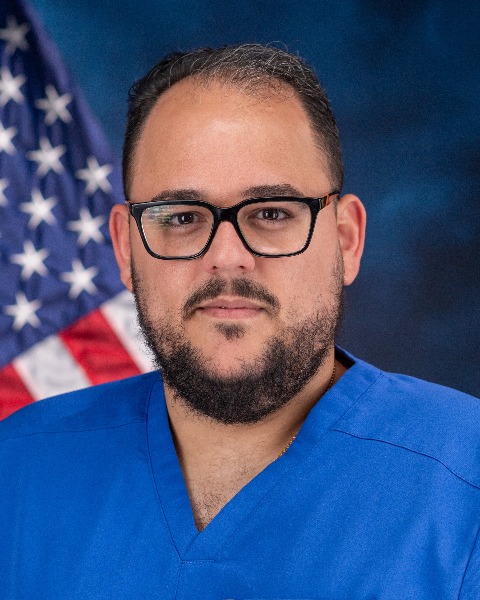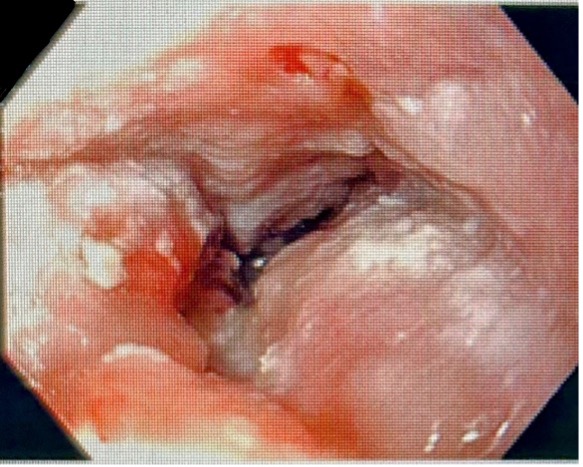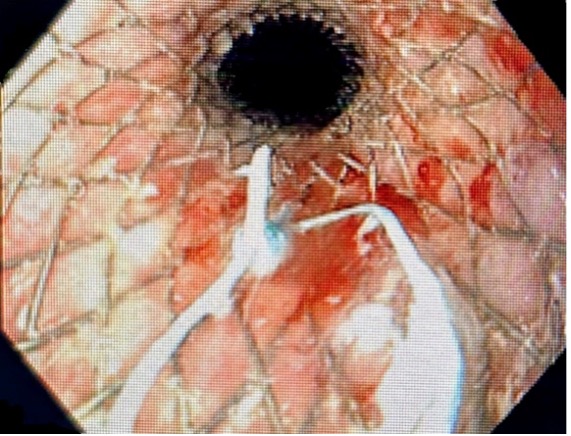Tuesday Poster Session
Category: Esophagus
P4995 - Incidental Verrucous Carcinoma of the Esophagus in a Patient With HIV
Tuesday, October 28, 2025
10:30 AM - 4:00 PM PDT
Location: Exhibit Hall

Marco Hernandez Alberdi, MD
UCF-HCA Healthcare GME (Greater Orlando/Osceola)
Kissimmee, FL
Presenting Author(s)
Marco Hernandez Alberdi, MD1, Saud Khan, MD2, Feras Al-Moussally, MD3, Faris Alamin, MD1, Seela Ramesh, MD4
1UCF-HCA Healthcare GME (Greater Orlando/Osceola), Kissimmee, FL; 2UCF/HCA Greater Orlando/Osceola, Kissimmee, FL; 3HCA Osceola, Kissimmee, FL; 4University of Central Florida College of Medicine, Orlando, FL
Introduction: Verrucous carcinoma (VC) is a slow growing, rare subtype of squamous cell carcinoma with fewer than 50 cases reported in literature. Risk factors include chronic mucosal irritation, tobacco use, alcohol use, achalasia, and possibly human papilloma virus. Although rare, VC can occur in the gastrointestinal tract.
Case Description/
Methods: A 59-year-old woman with a history of HIV controlled on antiretroviral therapy, recent 25-pound weight loss and advanced dementia was brought to the emergency with altered mentation. Physical examination revealed diffuse muscle wasting and mild epigastric tenderness. Imaging revealed thickening of the esophageal wall without any lymph node enlargement. Esophagram demonstrated multiple constrictions in the lower third of the esophagus. Endoscopy revealed an irregular circumferential mass with fibrotic-appearing tissue and significant luminal narrowing with proximal extent at 28cm (figure 1). Initial biopsy showed normal squamous mucosa, but deeper biopsies revealed atypical squamous cells. She was diagnosed with esophageal VC based on endoscopic and histopathologic findings. She was not a candidate for surgical resection, so an esophageal stent was placed (figure 2) to enable oral intake, and she was discharged home under family’s care.
Discussion: Verrucous carcinoma is a rare variant of squamous cell carcinoma, occurring in older adults with risk factors for chronic inflammation, and more recent associations with human papilloma virus. VC with esophageal involvement is exceedingly rare. While patients with VC typically present with obstructive symptoms, this patient’s advanced dementia made dysphagia evaluation difficult, possibly masking early symptoms. Even in advanced cases such as this, initial endoscopic biopsy may be inconclusive due to minimal superficial atypia. Multiple deep biopsies are often necessary for an accurate diagnosis. HIV patients remain at elevated risk for various cancers despite being on highly active antiretroviral therapy. Chronic inflammation and immune dysregulation in HIV may accelerate malignancy development. Early stages can be surgically resected. Advanced cases, or non-surgical candidates like our patient can be temporized with an esophageal stent. No clear data exists for effective medication or radiation therapy, however recent cases report good outcomes with combined chemo-radiation. This case adds to the literature regarding the presentation of this rare and interesting lesion.

Figure: Figure 1 - endoscopic view of an irregular circumferential mass with fibrotic-appearing tissue and significant luminal narrowing

Figure: Figure 2 – esophageal stenting of the mass
Disclosures:
Marco Hernandez Alberdi indicated no relevant financial relationships.
Saud Khan indicated no relevant financial relationships.
Feras Al-Moussally indicated no relevant financial relationships.
Faris Alamin indicated no relevant financial relationships.
Seela Ramesh indicated no relevant financial relationships.
Marco Hernandez Alberdi, MD1, Saud Khan, MD2, Feras Al-Moussally, MD3, Faris Alamin, MD1, Seela Ramesh, MD4. P4995 - Incidental Verrucous Carcinoma of the Esophagus in a Patient With HIV, ACG 2025 Annual Scientific Meeting Abstracts. Phoenix, AZ: American College of Gastroenterology.
1UCF-HCA Healthcare GME (Greater Orlando/Osceola), Kissimmee, FL; 2UCF/HCA Greater Orlando/Osceola, Kissimmee, FL; 3HCA Osceola, Kissimmee, FL; 4University of Central Florida College of Medicine, Orlando, FL
Introduction: Verrucous carcinoma (VC) is a slow growing, rare subtype of squamous cell carcinoma with fewer than 50 cases reported in literature. Risk factors include chronic mucosal irritation, tobacco use, alcohol use, achalasia, and possibly human papilloma virus. Although rare, VC can occur in the gastrointestinal tract.
Case Description/
Methods: A 59-year-old woman with a history of HIV controlled on antiretroviral therapy, recent 25-pound weight loss and advanced dementia was brought to the emergency with altered mentation. Physical examination revealed diffuse muscle wasting and mild epigastric tenderness. Imaging revealed thickening of the esophageal wall without any lymph node enlargement. Esophagram demonstrated multiple constrictions in the lower third of the esophagus. Endoscopy revealed an irregular circumferential mass with fibrotic-appearing tissue and significant luminal narrowing with proximal extent at 28cm (figure 1). Initial biopsy showed normal squamous mucosa, but deeper biopsies revealed atypical squamous cells. She was diagnosed with esophageal VC based on endoscopic and histopathologic findings. She was not a candidate for surgical resection, so an esophageal stent was placed (figure 2) to enable oral intake, and she was discharged home under family’s care.
Discussion: Verrucous carcinoma is a rare variant of squamous cell carcinoma, occurring in older adults with risk factors for chronic inflammation, and more recent associations with human papilloma virus. VC with esophageal involvement is exceedingly rare. While patients with VC typically present with obstructive symptoms, this patient’s advanced dementia made dysphagia evaluation difficult, possibly masking early symptoms. Even in advanced cases such as this, initial endoscopic biopsy may be inconclusive due to minimal superficial atypia. Multiple deep biopsies are often necessary for an accurate diagnosis. HIV patients remain at elevated risk for various cancers despite being on highly active antiretroviral therapy. Chronic inflammation and immune dysregulation in HIV may accelerate malignancy development. Early stages can be surgically resected. Advanced cases, or non-surgical candidates like our patient can be temporized with an esophageal stent. No clear data exists for effective medication or radiation therapy, however recent cases report good outcomes with combined chemo-radiation. This case adds to the literature regarding the presentation of this rare and interesting lesion.

Figure: Figure 1 - endoscopic view of an irregular circumferential mass with fibrotic-appearing tissue and significant luminal narrowing

Figure: Figure 2 – esophageal stenting of the mass
Disclosures:
Marco Hernandez Alberdi indicated no relevant financial relationships.
Saud Khan indicated no relevant financial relationships.
Feras Al-Moussally indicated no relevant financial relationships.
Faris Alamin indicated no relevant financial relationships.
Seela Ramesh indicated no relevant financial relationships.
Marco Hernandez Alberdi, MD1, Saud Khan, MD2, Feras Al-Moussally, MD3, Faris Alamin, MD1, Seela Ramesh, MD4. P4995 - Incidental Verrucous Carcinoma of the Esophagus in a Patient With HIV, ACG 2025 Annual Scientific Meeting Abstracts. Phoenix, AZ: American College of Gastroenterology.
